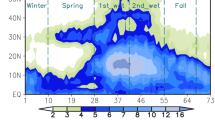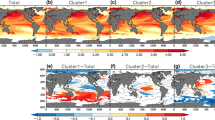Abstract
The South Asian High (SAH) and precipitation over East Asia simulated by 11 coupled GCMs associated with the forthcoming Intergovernmental Panel on Climate Change’s (IPCC) 4th Assessment Report are evaluated. The seasonal behavior of the SAH is presented for each model. Analyses of the results show that all models are able to reproduce the seasonal cycle of the SAH. Locations of the SAH center are also basically reproduced by these models. All models underestimate the intensity and the extension of coverage in summer. The anomalous SAH can be divided into east and west modes according to its longitudinal position in summer on the interannual timescale, and the composite anomalies of the observed precipitation for these two modes tend to have opposite signs over East Asia. However, only several coupled GCMs can simulate the relationship between rainfall and SAH similar to the observed one, which may be associated with the bias in simulation of the subtropical anticyclone over the West Pacific (SAWP) at 500 hPa. In fact, it is found that any coupled GCM, that can reproduce the reasonable summer mean state of SAWP and the southward (northward) withdrawal (extension) for the east (west) mode of SAH as compared to the observed, will also simulate similar rainfall anomaly patterns for the east and west SAH modes over East Asia. Further analysis indicates that the observed variations in the SAH, SAWP and rainfall are closely related to the sea surface temperature (SST) over the equatorial tropical Pacific. Particularly, some models cannot simulate the SAWP extending northward in the west mode and withdrawing southward in the east mode, which may be related to weak major El Niño or La Niña events. The abilities of the coupled GCMs to simulate the SAWP and ENSO events are associated partly with their ability to reproduce the observed relationship between SAH and the rainfall anomaly over East Asia.
Similar content being viewed by others
References
Wang, B., R., Wu, and X., Fu, 2000: Pacific-East Asian teleconnection: How does ENSO affect East Asian climate? J. Climate, 13, 1517–1536.
Delworth, T. L., and Coauthors, 2004: GFDL’s CM2 global coupled climate models—part 1: Formulation and simulation characteristics. J. Climate, 19, 643–674.
Flato, G., and G. Boer, 2001: Warming asymmetry in climate shange simulation. Geophys. Res. Lett., 28, 195–198.
Flohn, H., 1960: Recent investigation on the mechanism of the “summer monsoon” of southern and eastern Asia. Proc. Symp. Monsoon of the World, New Delhi, Hind Union Press, 75–88.
Gordon, C., and Coauthors, 2000: Simulation of SST, sea ice extents and ocean heat transports in a version of the Hadley Centre coupled model without flux adjustments. Climate Dyn., 16, 147–168.
Goosse, H., and T. Fichefet, 1999: Importance of ice-ocean interactions for the global ocean circulation: A model study. J. Geophys. Res., 104, 23337–23355.
Huang Ronghui, and Wu Yifang, 1989: The influence of ENSO on the summer climate change in China and its mechanisms. Adv. Atmos. Sci, 6, 21–32.
Kalnay, E., and Coauthors, 1996: The NCEP/NCAR 40-year reanalysis project. Bull. Amer. Meteor. Soc., 77, 437–471.
Kiehl, J. T., and P. R. Gent, 2004: The Community Climate System Model, Version Two. J. Climate, 17, 3666–3682.
K-1 model developers, 2004: K-1 coupled model (MIROC) description, K-1 technical report, 1. H. Hasumi and S. Emori, Eds., Center for Climate System Research, University of Tokyo, 34pp.
Liu Xuanfei, Zhu Qiangen, and Guo Pinwen, 2000: Conversion characteristics between barotropic and baroclinic circulations of the SAH and its seasonal evolution. Adv. Atmos. Sci., 17(1), 129–139.
Mason, R. B., and C. E. Anderson, 1958: The development and decay of the 100mb summertime anticyclone over southern Asia. Mon. Wea. Rev., 91, 3–12.
Qian Yongfu, Yan Hong, Wang Qianqian, and Wang Anyu, 1988: Numerical Study on the Orographic Effect in the Planetary Atmosphere. Science Press, Beijing, 217pp. (in Chinese)
Qian Yongfu, Zhang Qiong, Yao Yonghong, and Zhang Xuehong, 2002: Seasonal variation and heat preference of the South Asia High. Adv. Atmos. Sci., 19(5), 821–836.
Rayner, N. A., E. B. Horton, D. E. Parker, C. K. Folland, and R. B. Hackett, 1996: Version 2.2 of the Global Sea-Ice and Sea Surface Temperature Data Set, 1903–1994. Climate Research Technical Note 74, 1–21.
Roeckner, E., and Coauthors, 2003: The atmospheric general circulation model ECHAM5. Part I: Model description. Max Planck Institute for Meteorology Rep., 349, 127pp. [available from MPI for Meteorology, Bundesstr. 53, 20146 Hamburg, Germany]
Russell, G., J. Miller, and D. Rind, 1995: A coupled atmosphere-ocean model for transient climate change studies. Atmos.-Ocean, 33, 683–730.
Sun Guowu, 1984: Study on seasonal variation of the South Asia High. Papers on the Tibetan Plateau Meteorological Experiment (Part II). Science Press, Beijing, 152–158. (in Chinese)
Tao Shiyan, and Zhu Fukang, 1964: The variation of 100 mb circulation over South Asia in summer and its association with march and withdraw of West Pacific Subtropical High. Acta Meteorologica Sinica, 34, 385–395. (in Chinese)
Xie, P., and P. A. Arkin, 1996: Analyses of global monthly precipitation using gauge observations, satellite estimates, and numerical model predictions. J. Climate, 9, 840–858.
Yu Yongqiang, Zhang Xuehong, and Guo Yufu, 2004: Global coupled ocean-atmosphere general circulation models in LASG/IAP. Adv. Atmos. Sci., 21, 444–455.
Zhang Qiong, Qian Yongfu, and Zhang Xuehong, 2000: Interannual and interdecadal variations of the South Asia High. Chinese J. Atmos. Sci., 24(1), 67–78. (in Chinese).
Zhang Qiong, and Wu Guoxiong, 2001: The large area flood and drought over Yangtze River Valley and its relation to the South Asia High. Acta Meteorologica Sinica, 59(5), 569–577. (in Chinese)
Zhang Qiong, Wu Guoxiong, and Qian Yongfu, 2002: The bimodality of the 100 hPa South Asia High and its relationship to the climate anomaly over East Asia in summer. J. Meteor. Soc. Japan, 80(4), 733–744.
Zhang, R., A. Sumi, and M. Kimoto, 1996: Impact of El Niño on the East Asian monsoon: A diagnostic study of the’ 86/87 and’ 91/92 events. J. Meteor. Soc. Japan, 74, 49–62.
Zhu Fukang, Lu Longhua, Chen Xianji, and Zhao Wei, 1980: The South Asia High. Science Press, Beijing, 95pp. (in Chinese)
Zou Jianfeng, 1991: Numerical simulation of meridional shift of South Asia High ridge line. Acta Meteorologica Sinica, 49(1), 96–99. (in Chinese)
Author information
Authors and Affiliations
Rights and permissions
About this article
Cite this article
Zhou, N., Yu, Y. & Qian, Y. Simulations of the 100-hPa South Asian High and precipitation over East Asia with IPCC coupled GCMs. Adv. Atmos. Sci. 23, 375–390 (2006). https://doi.org/10.1007/s00376-006-0375-9
Received:
Revised:
Issue Date:
DOI: https://doi.org/10.1007/s00376-006-0375-9




